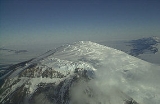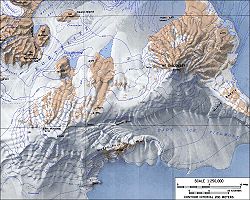
Mount Discovery
Encyclopedia
Mount Discovery is a conspicuous, isolated stratovolcano
, lying at the head of McMurdo Sound
and east of Koettlitz Glacier
, overlooking the NW portion of the Ross Ice Shelf
. It forms the center of a three-armed mass of which Brown Peninsula
is one extension to the north; Minna Bluff is a second to the east; the third is Mount Morning
to the west.
Discovered by the British National Antarctic Expedition (1901–04) and named for their expedition ship Discovery
.

Stratovolcano
A stratovolcano, also known as a composite volcano, is a tall, conical volcano built up by many layers of hardened lava, tephra, pumice, and volcanic ash. Unlike shield volcanoes, stratovolcanoes are characterized by a steep profile and periodic, explosive eruptions...
, lying at the head of McMurdo Sound
McMurdo Sound
The ice-clogged waters of Antarctica's McMurdo Sound extend about 55 km long and wide. The sound opens into the Ross Sea to the north. The Royal Society Range rises from sea level to 13,205 feet on the western shoreline. The nearby McMurdo Ice Shelf scribes McMurdo Sound's southern boundary...
and east of Koettlitz Glacier
Koettlitz Glacier
The Koettlitz Glacier is a large Antarctic glacier lying west of Mount Morning and Mount Discovery, flowing from the vicinity of Mount Cocks northeastward between Brown Peninsula and the mainland into the ice shelf of McMurdo Sound....
, overlooking the NW portion of the Ross Ice Shelf
Ross Ice Shelf
The Ross Ice Shelf is the largest ice shelf of Antarctica . It is several hundred metres thick. The nearly vertical ice front to the open sea is more than 600 km long, and between 15 and 50 metres high above the water surface...
. It forms the center of a three-armed mass of which Brown Peninsula
Brown Peninsula
Brown Peninsula is a nearly ice-free peninsula, long and wide, which rises above the Ross Ice Shelf northward of Mount Discovery, to which it is connected by a low isthmus. It was discovered by the British National Antarctic Expedition, 1901–04, which named it "Brown Island" because of its color...
is one extension to the north; Minna Bluff is a second to the east; the third is Mount Morning
Mount Morning
Mount Morning is a dome-shaped stratovolcano standing WSW of Mount Discovery and east of Koettlitz Glacier in Victoria Land. Discovered by the British National Antarctic Expedition which named it for the Morning, relief ship to the expedition....
to the west.
Discovered by the British National Antarctic Expedition (1901–04) and named for their expedition ship Discovery
RRS Discovery
The RRS Discovery was the last traditional wooden three-masted ship to be built in Britain. Designed for Antarctic research, she was launched in 1901. Her first mission was the British National Antarctic Expedition, carrying Robert Falcon Scott and Ernest Shackleton on their first, successful...
.


